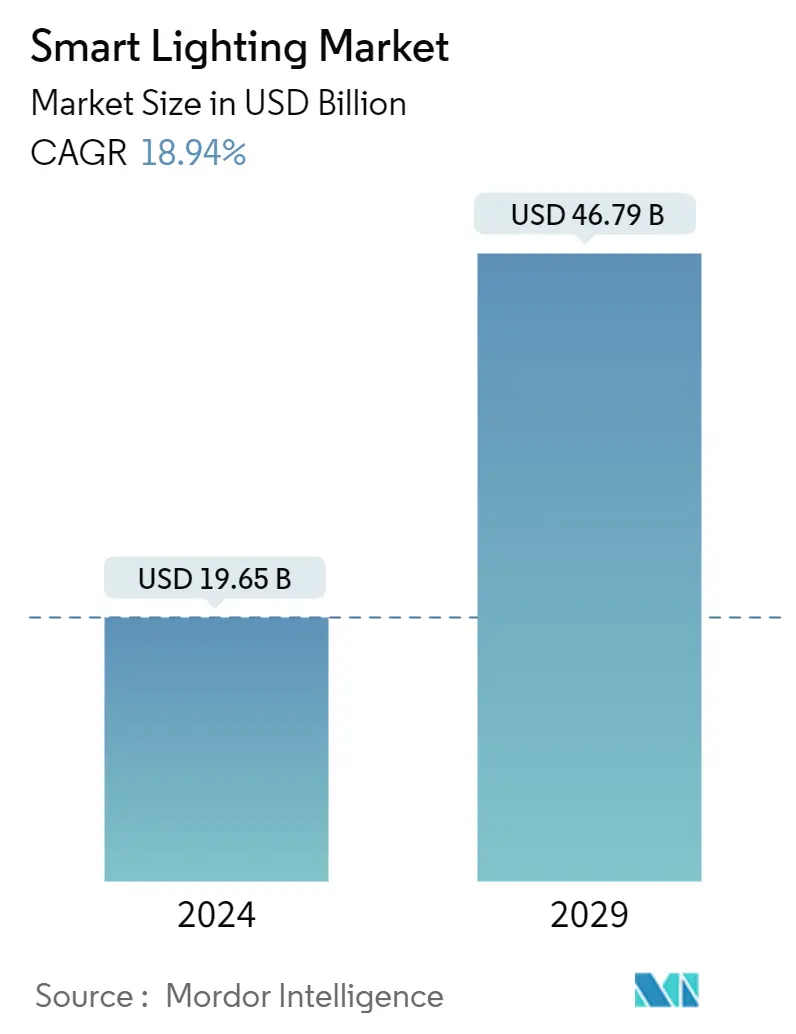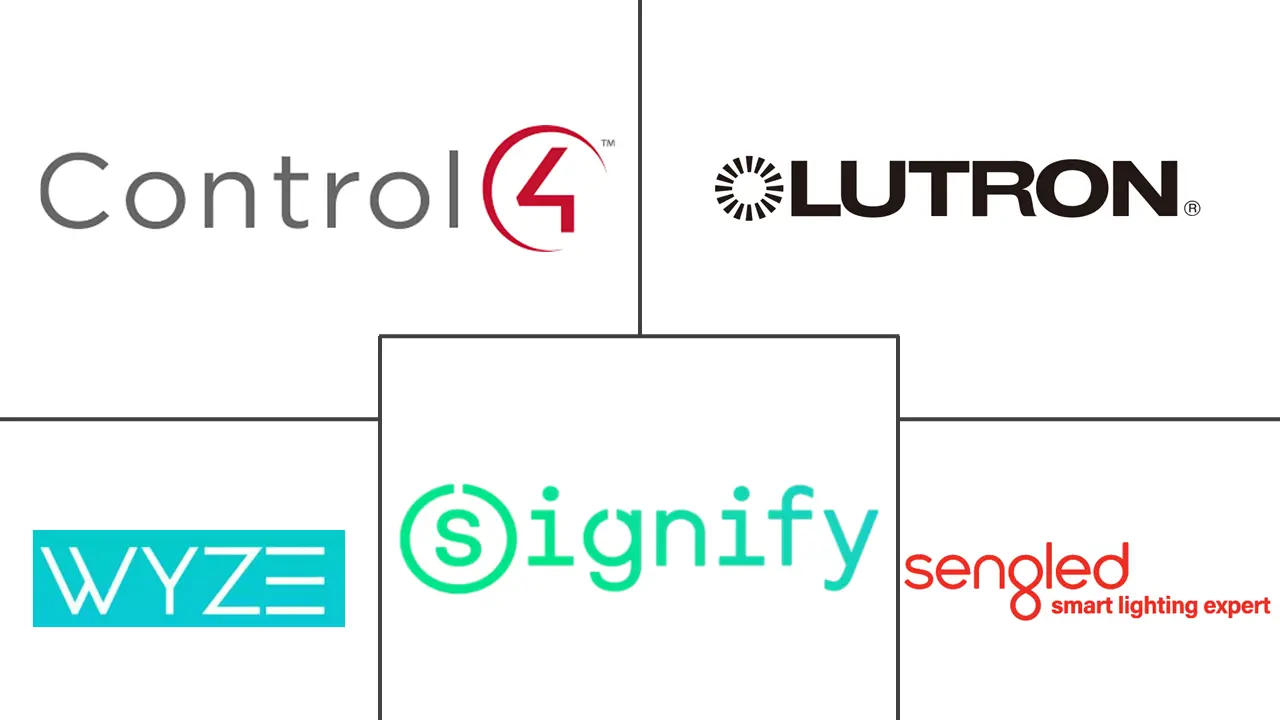Market Size of Smart Lighting Industry

| Study Period | 2019 - 2029 |
| Market Size (2024) | USD 19.65 Billion |
| Market Size (2029) | USD 46.79 Billion |
| CAGR (2024 - 2029) | 18.94 % |
| Fastest Growing Market | Asia-Pacific |
| Largest Market | Europe |
Major Players
*Disclaimer: Major Players sorted in no particular order |
Smart Lighting Market Analysis
The Smart Lighting Market size is estimated at USD 19.65 billion in 2024, and is expected to reach USD 46.79 billion by 2029, growing at a CAGR of 18.94% during the forecast period (2024-2029).
Due to its societal benefits, consumers might adopt energy-efficient LED technology more rapidly, so replacing the inferior compact fluorescent or halogen lighting technologies could be accelerated.
- The popularity and demand for lights have grown in both commercial and residential spaces due to their ability to connect with IoT devices and generate a variety of ambient lighting using only smartphones or tablets. Smart lights can be dimmed with different color tones depending on the situation, schedule their on/off times, track their energy consumption, and connect to other devices via Wi-Fi, Bluetooth, SmartThings, Z-Wave, or ZigBee.
- Office spaces are also emerging as one of the common smart lighting applications. In today's business world, owners and managers are placing more emphasis on the overall well-being of their employees. By switching to smart lighting, offices can provide bright light for their employees. This helps them see better and experience less eye fatigue. Additionally, the color of the light can help brighten moods and provide comfort.
- Furthermore, favorable government regulations regarding conventional lighting and energy consumption across the United States, the European Union, China, and India are anticipated to favor the market demand for connected LED lighting.
- However, the slow growth of the smart lighting market may result in entrepreneurial challenges. The consequences of a market entry failure for producers of smart-lighting products comprise significant sunk investments and reputational damage. To address these concerns, manufacturers are finding the need to consider consumer views of smart-home technologies in general and smart-lighting products in particular.
- The emergence of COVID-19 caused a halt in production and disruption throughout the supply chain, impairing industrial output growth and reducing the capacity for light manufacturing across important manufacturing hubs. However, as people spent more time at home, they became more inclined to upgrade the interiors, which positively impacted the market. Additionally, it is anticipated that the growing use of LEDs in homes and the penetration of smart home technology will further fuel market growth in the coming years.
Smart Lighting Industry Segmentation
Smart/connected lighting is defined as an LED-based system with sensors and controllers that are networked (wired or wireless) and enable the lighting products within the system to communicate with each other and transmit data. LED lighting solutions that allow them to be connected, customized, scheduled, and remotely controlled include smart lamps, bulbs, and luminaires. Lighting controls include sensors, user interfaces, controllers, and light management software.
The smart lighting market is segmented into product type (control systems (wired, wireless), smart lamps and fixtures) and geography (North America (United States, Canada), Europe (United Kingdom, Germany, France, Spain, and Rest of Europe), Asia-Pacific (China, Japan, India, Rest of Asia-Pacific), Latin America, Middle East and Africa). The market sizes and forecasts are provided in terms of value (USD) for all the above segments.
| By Product Type | ||||
| ||||
| Smart Lamps and Fixtures |
| By Geography | |||||||
| |||||||
| |||||||
| |||||||
| Latin America | |||||||
| Middle East and Africa |
Smart Lighting Market Size Summary
The smart lighting market is experiencing significant growth, driven by the increasing adoption of energy-efficient LED technology and the integration of Internet of Things (IoT) capabilities. This market expansion is fueled by the demand for smart lighting solutions in both commercial and residential spaces, where users can control lighting through smartphones or tablets, adjusting brightness and color tones to suit various moods and settings. The shift towards smart lighting is also supported by favorable government regulations promoting energy efficiency and the phasing out of traditional lighting technologies. These regulations, along with the declining costs of LED technology, are expected to further boost market demand across regions such as the United States, Europe, China, and India.
The competitive landscape of the smart lighting market is characterized by the presence of major players like Signify Holding, Control4 Corp., and Savant, who are actively expanding their market presence through strategic acquisitions and partnerships. The market is also witnessing innovations such as intelligent street lighting and smart home ecosystems, which enhance connectivity and user experience. Despite challenges like slow market growth and the impact of COVID-19 on production and supply chains, the market is poised for growth, driven by the increasing penetration of smart home technologies and the rising demand for energy-efficient lighting solutions in various sectors, including residential, healthcare, and commercial spaces.
Smart Lighting Market Size - Table of Contents
-
1. MARKET INSIGHTS
-
1.1 Market Overview
-
1.2 Industry Attractiveness - Porter's Five Forces Analysis
-
1.2.1 Bargaining Power of Suppliers
-
1.2.2 Bargaining Power of Buyers
-
1.2.3 Threat of New Entrants
-
1.2.4 Threat of Substitutes
-
1.2.5 Degree of Competition
-
-
1.3 Industry Value Chain Analysis
-
1.4 Impact of COVID-19 on the Smart Lighting Industry
-
1.5 PESTLE Analysis
-
-
2. MARKET SEGMENTATION
-
2.1 By Product Type
-
2.1.1 Control System
-
2.1.1.1 Wired
-
2.1.1.2 Wireless
-
-
2.1.2 Smart Lamps and Fixtures
-
-
2.2 By Geography
-
2.2.1 North America
-
2.2.1.1 United States
-
2.2.1.2 Canada
-
-
2.2.2 Europe
-
2.2.2.1 United Kingdom
-
2.2.2.2 Germany
-
2.2.2.3 France
-
2.2.2.4 Spain
-
2.2.2.5 Rest of Europe
-
-
2.2.3 Asia-Pacific
-
2.2.3.1 China
-
2.2.3.2 Japan
-
2.2.3.3 India
-
2.2.3.4 Rest of Asia-Pacific
-
-
2.2.4 Latin America
-
2.2.5 Middle East and Africa
-
-
Smart Lighting Market Size FAQs
How big is the Smart Lighting Market?
The Smart Lighting Market size is expected to reach USD 19.65 billion in 2024 and grow at a CAGR of 18.94% to reach USD 46.79 billion by 2029.
What is the current Smart Lighting Market size?
In 2024, the Smart Lighting Market size is expected to reach USD 19.65 billion.

